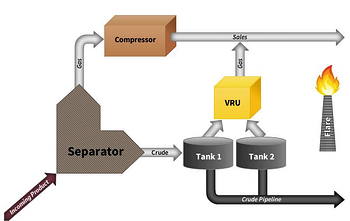 Alternate Operating Scenarios (AOS) and Maintenance, Startup and Shutdown (MSS) operating scenarios are particularly difficult concepts to distinguish between for the Oil & Gas and Petrochemical Industries. But knowing the difference between the two, and understanding how each one affects your emissions tracking and reporting obligations is paramount to keeping your facility in compliance.
Alternate Operating Scenarios (AOS) and Maintenance, Startup and Shutdown (MSS) operating scenarios are particularly difficult concepts to distinguish between for the Oil & Gas and Petrochemical Industries. But knowing the difference between the two, and understanding how each one affects your emissions tracking and reporting obligations is paramount to keeping your facility in compliance.
ERA Environmental Management Solutions has prepared a free guide that outlines the difference between an AOS and MSS, how your reporting should respond to each, and best practices for your EH&S team. This short article will give you some of the highlights and introduce key concepts to help you understand this important topic.
Understanding Maintenance, Startup, Shutdown Events
Maintenance, Startup, and Shutdown events are tasks that you undertake in order to ensure the smooth and ongoing operations of your equipment and processes, but are not part of your everyday production tasks. MSS events fall into two categories: planned and unplanned.
Planned MSS: a routine and deliberate activity that occurs on a reliable schedule. For example, you might have a planned MSS activity once a year, after 1,000 hours of operating a piece of machinery, or once per shift. The scheduling of these types of events is flexible and based on your needs. For an MSS activity to be a planned one you don’t need to know the exact time and date it will occur, just know the schedule at which to expect it (i.e. The first Monday of every month is an acceptable schedule without having to list the date of each first Monday per month).
Understanding how to write schedules for MSS events is essential, since some states now require you to submit an annual schedule for all your MSS events ahead of time. For example, the state of Texas required all Oil & Gas facilities to declare submit their year’s MSS events by January 5, 2014 (under Permit By Rule 106.359). Any MSS activities that were not submitted and approved would be considered to be unplanned instead, even if the owner/operator had scheduled the MSS event internally. Some states, like Texas, also take away a manufacturer’s ability to use the Affirmative Defense to protect themselves from unpreventable malfunctions - more on that later.
Unplanned MSS: Unplanned MSS activities are those actions you take in response to unpreventable and unanticipated malfunctions or equipment failures. Whereas planned MSS events are designed to prevent malfunctions before they happen, an unplanned MSS event typically takes place to resolve an unpreventable equipment malfunction. Unfortunately, one of the biggest consequences of an unplanned MSS event is a sudden release of uncontrolled air contaminants - which puts your compliance record at risk. EH&S Managers should take extra precautions and care during these unexpected malfunctions, since you’ll need to know exactly which emissions became fugitive, the quantity of emissions released, the length of the unplanned MSS event, and exactly which responsive actions took place.
Affirmative Defense for MSS
Since unplanned MSS events are meant to be unpreventable, the EPA does allow some lenience for businesses that experience an unplanned MSS event. There is an Affirmative Defense available for responsible manufacturers that did everything possible to prevent the malfunction and resulting emissions. The Affirmative Defense may reduce your penalties or prevent them altogether depending on how much your emissions exceeded permissible limits.
However, there are specific general requirements for applying the Affirmative Defense, as well as state-specific requirements:
- You must have recorded and reported all fugitive emissions from the event to the proper regulatory enforcement agency within your assigned timelines.
- You must prove that the period of unauthorized emissions could not have been prevented through proper planning or design. There had to be no way of anticipating or avoiding the malfunction (i.e. a piece of control equipment breaking down to manufacturer error rather than your failure to maintain the equipment per manufacturer’s instructions).
- The unauthorized emissions are not part of a pattern that would indicate a flaw in your operations, design, or maintenance.
- If the emissions were the result of bypassing a piece of control equipment, that bypass was necessary in order to prevent loss of life, personal injury, or severe property damage.
- The facility and control equipment were operated according to best practices for minimizing emissions at all times.
- You acted immediately and took all possible steps to minimize the MSS event’s impact on the environment.
- If possible, all monitoring equipment was kept in operation.
- All actions taken to resolve the MSS event were documented and signed off on by the owner/operator.
- Total MSS emissions did not cause or contribute to an exceedance of the NAAQS, PSD increments, or a condition of air pollution.
In short, although helpful to responsible manufacturers, the Affirmative Defense requires a great deal of paperwork, monitoring, and emissions tracking. Proving all of the above points falls on the shoulder of the Affirmative Defense applicant, which means all of your paperwork before, during, and after the MSS event needs to be pristine… possibly as far back as five years when you need to prove the event was not part of a recurring pattern.
Understanding Alternate Operating Scenarios (AOS)
An AOS is a mechanism designed to allow a facility to deviate from its regular operations on the condition that the facility’s emissions do not exceed permit limits, and for a temporary period.
The primary reason for an AOS is to reroute the flow of emission-generating materials through your processes so that you can perform maintenance on a piece of equipment without entirely stopping production.
For example, say crude oil is sent to a tank on site, with emissions being recovered by a Vapor Recovery Unit (VRU) and the crude is sent down a pipeline. If the VRU requires maintenance, the operator can either shut down production, let the emissions become fugitive and compromise regulatory compliance, or reroute the vapors to a flare. Since the first two options are undesirable, the operator would send the vapors to a flare in order to keep emissions within permit levels.
This temporary rerouting is an Alternate Operating Scenario, and would be permissible up to the point where air emissions exceed permit limits. Depending on the method and effectiveness of the control technology (or lack thereof) being rerouted to, this AOS period will vary in length.
All possible AOSs for your facility must be written into your permit and approved by regulators before you begin operations. They must be revisited any time you want to add a new piece of equipment (i.e. an additional tank to your tank battery), requiring a great deal of forethought.
AOS and MSS: Knowing the Difference
Alternate Operating Scenarios are closely related to MSS events, but with critical differences. Until recently, the lines between an AOS and MSS were somewhat blurry, and many businesses incorrectly reported AOS emissions under the MSS umbrella. Now, state regulators have clarified the difference between the two and made clear the compliance expectations for both.
In both AOS and MSS, a piece of equipment is taken offline for maintenance reasons.
In reality, an MSS and AOS typically occur at the same time. In the above example, shutting down the VRU for planned maintenance would be a planned MSS event, and the rerouting to a flare would be an AOS, both occurring simultaneously.
The critical difference is how an EH&S Manager is required to track and report those emissions. In the MSS shutdown of the VRU, there would be gas left in the unit that escapes, uncontrolled, into the atmosphere. These emissions are the ones reported as MSS emissions.
In contrast, all of the emissions related to the facility’s operations under the temporary rerouting to a flare - the emissions of the entire process flow, not just air emissions via the flare - are tracked and reported as AOS emissions.
Tracking AOS emissions can be more difficult for a few reasons:
A) There are typically more emissions sources to monitor during an AOS versus an MSS;
B) You have to know how long you can run the AOS before you exceed your permit limits;
C) A facility will typically have several different AOSs to choose from, each with its own emission rate;
D) You must keep careful track of your AOS emissions and incorporate those into your overall annual/monthly/etc. emissions, as AOSs are not considered a special exception to your normal operations in terms of regulatory compliance.
Best Practice for AOS & MSS Management
The best technique for handling AOS and MSS emission tracking and reporting is to use an automated system that is able to do, at a minimum, the following:
1. Collect emissions data automatically from continuous emissions monitoring and continuous parametric monitoring systems (CEMS/CPMS). That way, if either occurs, you’ll have detailed, real-time records of how long the event lasted, what type of emissions were released, and when equipment was back in compliant condition.
2. Virtual Process Mapping allows you to model out the potential emissions from any of your AOS routes or MSS activities before they occur. This means you’ll be able to anticipate the quantity and type of emissions to report, as well as how long you can be in an AOS before your emissions exceed your permit limits.
3. A Centralized Database System that stores all your information about materials, emissions, control efficiencies, AOS emission rates, and MSS emissions in one place so that you have all the data you need for reports immediately accessible and in one spot. Considering how complex it can potentially be to prove your status for an Affirmative Defense, having everything in one spot makes it easier for you and your auditors to see the whole picture. Less wasted time and headaches for everyone involved.
ERA has developed a comprehensive and free downloadable guide that gives you even more information about MSS and AOS reporting, including important information about how to get AOSs approved, why EPA TANKS software might not be your best option for e-reporting tools, and how to prepare for using the Affirmative Defense.
Ask an ERA Expert:
Do you have any questions or concerns about the topic covered in this article? Want more insight? Now is your chance to ask one of ERA’s Environmental Specialists. Please leave your question or comment below and we’ll make sure one of our expert scientists responds.
This Blog Was Co-Authored By:


Tags:
Environmental Management
June 20, 2014

Comments